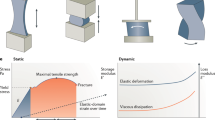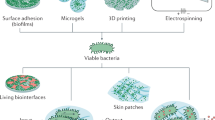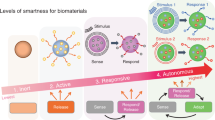Abstract
Biomaterials, traditionally defined as materials used in medical devices, have been used since antiquity, but recently their degree of sophistication has increased significantly. Biomaterials made today are routinely information rich and incorporate biologically active components derived from nature. In the future, biomaterials will assume an even greater role in medicine and will find use in a wide variety of non-medical applications through biologically inspired design and incorporation of dynamic behaviour.
This is a preview of subscription content, access via your institution
Access options
Subscribe to this journal
Receive 51 print issues and online access
$199.00 per year
only $3.90 per issue
Buy this article
- Purchase on Springer Link
- Instant access to full article PDF
Prices may be subject to local taxes which are calculated during checkout






Similar content being viewed by others
References
Ratner, B. D. & Bryant, S. J. Biomaterials: where we have been and where we are going. Annu. Rev. Biomed. Eng. 6, 41–75 (2004).This is an excellent, comprehensive review of the history of the biomaterials field.
Anderson, J. M., Rodriguez, A. & Chang, D. T. Foreign body reaction to biomaterials. Semin. Immunol. 20, 86–100 (2008).
Mroz, T., Yamashita, T. & Lieberman, I. The on- and off-label use of rhBMP-2 (INFUSE) in Medicare and non-Medicare patients. Spine J. 8, 41S–42S (2008).
Shahani, S. Advanced Drug Delivery Systems: New Developments, New Technologies. Report No. PHM006F (Business Communications Company, 2006).
King, R. G. & Donohue, G. F. Estimates of medical device spending in the United States. AMSA <http://www.amsa.org/AMSA/libraries/committee_docs/king_paper_medical_device_spending.sflb.ashx> (2007).
Shih, W. M., Quispe, J. D. & Joyce, G. F. A 1.7-kilobase single-stranded DNA that folds into a nanoscale octahedron. Nature 427, 618–621 (2004).
Shin, H., Zygourakis, K., Farach-Carson, M. C., Yaszemski, M. J. & Mikos, A. G. Attachment, proliferation, and migration of marrow stromal osteoblasts cultured on biomimetic hydrogels modified with an osteopontin-derived peptide. Biomaterials 25, 895–906 (2004).
Massia, S. P. & Hubbell, J. A. Covalently attached GRGD on polymer surfaces promotes biospecific adhesion of mammalian cells. Ann. NY Acad. Sci. 589, 261–270 (1990).
Silva, G. A. et al. Selective differentiation of neural progenitor cells by high-epitope density nanofibers. Science 303, 1352–1355 (2004).
Arnold, M. et al. Activation of integrin function by nanopatterned adhesive surfaces. ChemPhysChem 5, 383–388 (2004).
Wosnick, J. H. & Shoichet, M. S. Three-dimensional chemical patterning of transparent hydrogels. Chem. Mater. 20, 55–60 (2008).
Carrico, I. S. et al. Lithographic patterning of photoreactive cell-adhesive proteins. J. Am. Chem. Soc. 129, 4874–4875 (2007).
Lutolf, M. P. et al. Repair of bone defects using synthetic mimetics of collagenous extracellular matrices. Nature Biotechnol. 21, 513–518 (2003). This paper describes how materials can be designed to mimic key aspects of natural ECM (for example enzyme-mediated degradation) and function as templates for tissue regeneration.
Shin, K., Jayasuriya, A. C. & Kohn, D. H. Effect of ionic activity products on the structure and composition of mineral self assembled on three-dimensional poly(lactide-co-glycolide) scaffolds. J. Biomed. Mater. Res. A 83, 1076–1086 (2007).
Li, Y. J., Chung, E. H., Rodriguez, R. T., Firpo, M. T. & Healy, K. E. Hydrogels as artificial matrices for human embryonic stem cell self-renewal. J. Biomed. Mater. Res. A 79, 1–5 (2006).
Benoit, D. S., Schwartz, M. P., Durney, A. R. & Anseth, K. S. Small functional groups for controlled differentiation of hydrogel-encapsulated human mesenchymal stem cells. Nature Mater. 7, 816–823 (2008).
Shin'oka, T. et al. Midterm clinical results of tissue-engineered vascular autografts seeded with autologous bone marrow cells. J. Thorac. Cardiovasc. Surg. 129, 1330–1338 (2005).
Richardson, T. P., Peters, M. C., Ennett, A. B. & Mooney, D. J. Polymeric systems for dual growth factor delivery. Nature Biotechnol. 19, 1029–1034 (2001).
Phillips, J. E., Burns, K. L., Le Doux, J. M., Guldberg, R. E. & Garcia, A. J. Engineering graded tissue interfaces. Proc. Natl Acad. Sci. USA 105, 12170–12175 (2008).
Fan, V. H. et al. Tethered epidermal growth factor provides a survival advantage to mesenchymal stem cells. Stem Cells 25, 1241–1251 (2007).
Tsapis, N., Bennett, D., Jackson, B., Weitz, D. A. & Edwards, D. A. Trojan particles: large porous carriers of nanoparticles for drug delivery. Proc. Natl Acad. Sci. USA 99, 12001–12005 (2002).
Reddy, S. T. et al. Exploiting lymphatic transport and complement activation in nanoparticle vaccines. Nature Biotechnol. 25, 1159–1164 (2007).
Park, J. H. et al. Systematic surface engineering of magnetic nanoworms for in vivo tumor targeting. Small 5, 694–700 (2009).
Silva, E. A., Kim, E. S., Kong, H. J. & Mooney, D. J. Material-based deployment enhances the efficacy of endothelial progenitor cells. Proc. Natl Acad. Sci. USA 105, 14347–14352 (2008).
Ali, O. A., Huebsch, N., Cao, L., Dranoff, G. & Mooney, D. J. Infection-mimicking materials to program dendritic cells in situ . Nature Mater. 8, 151–158 (2009). This paper describes how biomaterials can be designed to regulate host biology at a distance by recruiting, locally programming and subsequently dispersing target cell populations to produce potent biological responses.
Engler, A. J., Sen, S., Sweeney, H. L. & Discher, D. E. Matrix elasticity directs stem cell lineage specification. Cell 126, 677–689 (2006). This paper demonstrates the importance of physical properties of biomaterials in controlling cellular response.
Tan, J. L. et al. Cells lying on a bed of microneedles: an approach to isolate mechanical force. Proc. Natl Acad. Sci. USA 100, 1484–1489 (2003).
Park, T. G. & Hoffman, A. S. Synthesis and characterization of pH- and or temperature-sensitive hydrogels. J. Appl. Polym. Sci. 46, 659–671 (1992).
Podual, K., Doyle, F. J. & Peppas, N. A. Glucose-sensitivity of glucose oxidase-containing cationic copolymer hydrogels having poly(ethylene glycol) grafts. J. Control. Release 67, 9–17 (2000).
Edelman, E. R., Brown, L., Taylor, J. & Langer, R. In vitro and in vivo kinetics of regulated drug release from polymer matrices by oscillating magnetic fields. J. Biomed. Mater. Res. 21, 339–353 (1987).
Alsberg, E., Feinstein, E., Joy, M. P., Prentiss, M. & Ingber, D. E. Magnetically-guided self-assembly of fibrin matrices with ordered nano-scale structure for tissue engineering. Tissue Eng. 12, 3247–3256 (2006).
Adams, D. S., Masi, A. & Levin, M. H+ pump-dependent changes in membrane voltage are an early mechanism necessary and sufficient to induce tail regeneration. Development 134, 1323–1335 (2007).
Lahann, J. et al. A reversibly switching surface. Science 299, 371–374 (2003).
Martinez, A. W., Phillips, S. T. & Whitesides, G. M. Three-dimensional microfluidic devices fabricated in layered paper and tape. Proc. Natl Acad. Sci. USA 105, 19606–19611 (2008).
Khetani, S. R. & Bhatia, S. N. Microscale culture of human liver cells for drug development. Nature Biotechnol. 26, 120–126 (2008).
Nagrath, S. et al. Isolation of rare circulating tumor cells in cancer patients by microchip technology. Nature 450, 1235–1239 (2007).
Stern, E. et al. Label-free immunodetection with CMOS-compatible semiconducting nanowires. Nature 445, 519–522 (2007).
Gupta, V. K., Dubrovsky, T. B. & Abbott, N. L. Optical amplification of ligand–receptor binding using liquid crystals. Science 279, 2077–2080 (1998).
Madri, J. A., Pratt, B. M. & Tucker, A. M. Phenotypic modulation of endothelial cells by transforming growth factor-β depends upon the composition and organization of the extracellular matrix. J. Cell Biol. 106, 1375–1384 (1988).
Fischbach, C. et al. Cancer cell angiogenic capability is regulated by 3D culture and integrin engagement. Proc. Natl Acad. Sci. USA 106, 399–404 (2009).
Ghajar, C. M. et al. The effect of matrix density on the regulation of 3-D capillary morphogenesis. Biophys. J. 94, 1930–1941 (2008).
Xu, M. et al. Encapsulated three-dimensional culture supports the development of nonhuman primate secondary follicles. Biol. Reprod. 81, 587–593 (2009).
Khademhosseini, A., Langer, R., Borenstein, J. & Vacanti, J. P. Microscale technologies for tissue engineering and biology. Proc. Natl Acad. Sci. USA 103, 2480–2487 (2006).
Lee, H., Scherer, N. F. & Messersmith, P. B. A reversible wet/dry adhesive inspired by mussels and geckos. Nature 448, 338–341 (2007).
Jeong, K. H., Kim, J. & Lee, L. P. Biologically inspired artificial compound eyes. Science 312, 557–561 (2006).
Nam, K. T. et al. Virus-enabled synthesis and assembly of nanowires for lithium ion battery electrodes. Science 312, 885–888 (2006). This paper discusses the engineering of non-medical materials through the templating of viruses. The precisely tuned patterns of spatial features of the natural organism promise distinct performance advantages.
Needleman, D. J. et al. Higher-order assembly of microtubules by counterions: from hexagonal bundles to living necklaces. Proc. Natl Acad. Sci. USA 101, 16099–16103 (2004).
Sidorenko, A., Krupenkin, T., Taylor, A., Fratzl, P. & Aizenberg, J. Reversible switching of hydrogel-actuated nanostructures into complex micropatterns. Science 315, 487–490 (2007).
Omabegho, T., Sha, R. & Seeman, N. C. A bipedal DNA Brownian motor with coordinated legs. Science 324, 67–71 (2009).
Kyriakides, T. R. et al. The CC chemokine ligand, CCL2/MCP1, participates in macrophage fusion and foreign body giant cell formation. Am. J. Pathol. 165, 2157–2166 (2004).
Acknowledgements
We thank D. Ingber for discussions. We acknowledge funding from the US National Institutes of Health (National Institute of Dental and Craniofacial Research). N.H. is supported by a National Science Foundation Graduate Research Fellowship.
Author information
Authors and Affiliations
Ethics declarations
Competing interests
The authors declare no competing financial interests.
Additional information
Reprints and permissions information is available at http://www.nature.com/reprints. The authors declare no competing financial interests. Correspondence should be addressed to D.J.M. (mooneyd@seas.harvard.edu).
Rights and permissions
About this article
Cite this article
Huebsch, N., Mooney, D. Inspiration and application in the evolution of biomaterials. Nature 462, 426–432 (2009). https://doi.org/10.1038/nature08601
Published:
Issue Date:
DOI: https://doi.org/10.1038/nature08601
This article is cited by
-
Nano-frictional mechano-reinforcing porous nanowires scaffolds
Friction (2024)
-
Nature-inspired micropatterns
Nature Reviews Methods Primers (2023)
-
Bioinspired chiral inorganic nanomaterials
Nature Reviews Bioengineering (2023)
-
Functionalization of nanocellulose using atom transfer radical polymerization and applications: a review
Cellulose (2023)
-
Recent Innovations in the Strategies for the Functionalization of Chitosan, Pectin, Alginate, Hyaluronic Acid, Dextran and Inulin Biomaterials for Anticancer Applications-A Review
Journal of Polymers and the Environment (2023)
Comments
By submitting a comment you agree to abide by our Terms and Community Guidelines. If you find something abusive or that does not comply with our terms or guidelines please flag it as inappropriate.



